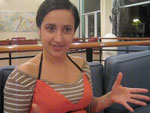THEA 10.2/WGST 59.03/AMES 25: Unveiling the Harem Dancer

Course: THEA 10.2/WGST 59.03/AMES 25: Unveiling the Harem Dancer
Instructor: Maral Yessayan
As part of the course Unveiling the Harem Dancer, the students were divided into working groups and asked to produce a video (2-5 minutes long) that creatively challenges stereotypes commonly associated with Arabs and Muslims. The course material for “Unveiling the Harem Dancer” focused on the role that visual media has historically played in creating a repertoire of images that sustain stereotypical descriptions of Arabs and Muslims. In response, I encouraged the students to use the same tool, i.e. the visual text, and capitalize on its ability to unsettle some of the stereotypes associated with Arabs and Muslims today. In my opinion, the projects were a great success. A focus on the visual medium seems to have enhanced the students’ understanding of the extent to which societies rely on visual difference to perpetuate ethnic, religious, and cultural stereotypes. The videos allowed students to actively engage in a dialogue with the prevailing discourse about Arabs and Muslims, which in turn enabled them to participate in a cross-cultural dialogue promoting values of tolerance and coexistence.
This video assignment also required each group to maintain a “Group Diary Blog,” which were made available to students on Blackboard. The purpose of the “Group Diary Blog” was to create a space for the students to flesh out their ideas, identify their research question, and define the vision of their video project in writing. It served as a productive forum for the students to brainstorm ideas, respond to one another, manage group meeting times, share information/graphics/links, organize and cite research material, and discuss the progress of their video project. It also provided me insight into the nature, process, and development of each of the groups’ video project, and allowed me to be more effective in directing and guiding the students whenever they had questions or faced challenges. Each group followed the “Video Project Proposal – The Pitch” and “Treatment Plan for Student Video Projects” guidelines provided by the JMC for their midterm. As part of their pitching presentation, however, I also encouraged them to create a preview video to practice using imovie software and to have a better feel on how to divide production tasks among group members for the video project. The groups screened their final videos at the end of week nine as part of an open public event that was followed by Q&A. The grading criteria for the final video project included three components:
Video Quality Production (from Concept to Creation) – 80 points
Video Supporting Group Paper – 10 points
‘Behind the Scenes’ Group Presentation – 10 points
Example of Final Video Project
https://www.youtube.com/watch?v=2gn9pNKcPyA
WGST 66-THEA 10: Hearing Voices Through Invisible Walls: The Art(s) of Facilitation
 Course: Hearing Voices Through Invisible Walls: The Art(s) of Facilitation
Course: Hearing Voices Through Invisible Walls: The Art(s) of Facilitation
Instructors: Ivy Schweitzer and Pati Hernandez
Video Project, 5-7 minute maximum, to be done in groups, shown to the Dartmouth Community, and assessed according to rubrics determined by the class (see below). This project is one of two culminating group projects for the course, whose overall theme is “Hearing Voices through Invisible Walls.” During the term, we study the way various arts and artists facilitate voices of people who usually go unheard in our society. Five artists, each working in different media, specifically photography/videography, theater, dance (two), and journalism, visited our class and presented their own theories and methods of facilitating voices. They talked to students specifically about their video projects and the issues these projects raised for them. Each visitor helped the students address crucial issues about how and why one facilitates someone’s voice; we encouraged students to think specifically about what they found helpful in these artists’ presentations by requiring them to write short “Critical Reflections” on each artist’s visit, which we commented on and graded.
Our first visitor, Greg Sharrow, an ethnographer at the Vermont Folk Life Center in Middlebury, VT, helped the students navigate a central issue. Our first reading assignment, Paolo Freire’s indispensable philosophy of liberated education, Pedagogy of the Oppressed, stressed the importance of dialogue. Sharrow stressed the importance of the involvement of the facilitator and the necessity of “deep hanging out” to equalize power inequalities between the interviewer (who has the camera and the desire to facilitate) and the interviewee (who faces the camera and may not want to have his/her voice facilitated). Thus, early on students got the idea that only one person could/should facilitate/interview. Greg uncovered a conflict in the class between those who wanted to do the projects in a group and those who wanted to be the solo interviewer. At the end of the class, the members elected to embrace both, and some students did, indeed, choose to work by themselves (though we assigned helpers to these students because edited solo is so time-consuming).
The goal of this project is for each group to produce a short video that facilitates the voice of someone in the Dartmouth community whom the members of the group feel is behind an “invisible wall.” The point is to use video technology and the art of video in the service of voice. Thus, the emphasis is on facilitation and not on the technical production of the videos. The subject of this video project will be determined by students’ specific interests and in consultation with the professors. In approaching their subject, we encouraged students to apply the ideas and methods described by our visiting artists, in the texts we have read and discussed in class, and in the resources on the Blackboard site provided by Susan Simon. This assignment is 20% of the final grade.
First, we required students to hand in a “pitch” to be discussed by the class. A few weeks later, we required students to submit a Video Project Treatment, a form that includes a short description of what they will do, what materials they will include, and what point they are trying to make, what roles everyone in the group will fill. We also asked them to include a short annotated bibliography (minimum of three sources, which can be drawn from the class readings and viewings), 1-2 pages. 5% of final grade.
Rubrics for student assessment of Video Projects: These rubrics were determined by members of the class through a discussion in class that took about 45 minutes. This discussion, although initially frustrating, was extremely helpful because it clarified the aspects of the project everyone thought was the most important––and that was “facilitation,” rather than technical aspects. Although students were, on the whole, leery about assessing each other’s work, even in groups, we felt the determining of rubrics helped them to clarify what was most important to them and to the class.
THEA 10/WGST 59 “Hearing Voices Through Invisible Walls: The Art(s) of Facilitation”
VIDEO PROJECT ASSESSMENTS
Please fill out as a group, one for each video not your own. This will be shown to the group that made the video, and we will use it to assign a grade for the groups on the video projects.
Name of Video:
Name of Students:
I. Facilitation- (40%) 100pts. ________________ x4 _____________
– mutual engagement
– comfort/space
– theory integration (praxis)
II. Organization (30%) 100 pts. _______________ x3 _______________
– focus
– goals
III. Overall Effect (20%) 100 pts. _______________ X2 ________________
– risk taking/daring
– creativity
IV. Production (10%) 100 pts. _______________ x1_________________
– citation
– transitions
TOTAL _______________
Scale:
A=100-95 (97.5)
A-= 94-90 (92.5)
B+=89-87 (88.5)
B =86-84 (85.5)
B-= 83=80 (82)
C+=79-77 (78.5)
C = 76-74 (75.5)
C-=73-70 (72)
D =69-6- (65)
Example of Final Video Project
WGST 51 / COLT 39: Mirror, Mirror on the Wall

Course: WGST 51/COLT 39 – Mirror, Mirror on the Wall
Instructor: Nancy Canepa
The Basics.
For your major project in this course you will be making a video together with 2 other students (i.e., groups of 3). Group selection is up to you; given the nature of the project, choose people whom you not only get along with, but who share your ideas on interesting directions in which to expand your experiences with fairy tales. You’ll make your videos using iMovie, and with the extensive help of the Jones Media Center (see syllabus for various instructional and tutorial sessions). Each video should be 5-7 minutes (please: no LONGER than 7 minutes!).
How to start thinking about it.
In your video you’ll be adapting or relating a fairy-tale type, paradigm, or set of motifs that you have encountered in the course to your own personal experience or to some aspect of modern life. The video may take a number of forms: theatrical/ cinematographic dramatization of a fairy tale (in whatever temporal and spatial dimension you like); a dramatized telling (incorporating visual material); a musical rendition (e.g., MTV-type video); a dramatized interview with one or more characters from a tale; a narration in images, etc. etc.! I’m open to and interested in other ideas, of course, but make sure to share them with me before you embark on the project.
How to frame your fairytale.
Approaches to “retelling” the tale or reconfiguring the motifs you choose may involve reversals of fairy-tale patterns or character types we have seen; sequels or prequels to familiar tale types; shifts in narration (e.g., from an objective 3rd-person narrator to a 1st-person narrator [one of the characters of the tale], or to an unreliable 3rd-person narrator); reframing the tale (e.g., changing its temporal and/or spatial coordinates); reinterpreting or zooming in on single episodes, elements, or characters of a tale.
The nitty gritty.
Throughout the process I will be distributing handouts to help you with the various phases of the project. To give you an idea of this process, these are the main steps:
- Choose your group, and brainstorm about possible ideas for your video.
- Create a proposal, and complete the treatment plan. (I’ll give you a form to help you.) Hand in a narrative summary of proposal/treatment (500 words).
- Showcase your ideas in a “pitch session” in which each group will have 5 minutes to present their proposal and then receive feedback from the rest of the class.
- Participate in 2 Imovie tutorials at Jones Media Center (during class hours), in which you’ll learn video-making techniques.
- Participate in 1 30-minute session in JMC before your group checks out a video camera.
- Put together a shot list (storyboard). This is optional. (Template provided.)
- Once footage is shot, participate in 1 or 2 editing sessions (depending on need) at JMC, with RWIT tutor.
- Complete video!
- Put together, as a class, pertinent criteria for evaluating the videos.
- Participate in a special showing of your videos.
- Write and hand in evaluations (both formal, based on class criteria, and less formal) (500 words).

